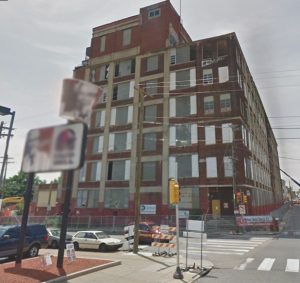Part 1: History of the Philadelphia Demolition Ordinance and the Apex Hosiery Building
This four-part series discusses how the collapse of a building during a demolition operation in Philadelphia in 2013, which resulted in several fatalities, led to enactment of a City Ordinance to prevent similar future calamities. As a result of the Ordinance, the author became involved with the structural investigation, review of the Site Safety Demolition Plan, and Demolition Special Inspections associated with the adaptive reuse of the Apex Hosiery Company Building located in Philadelphia.
As a result of the investigation, a unique type of reinforced concrete flat slab construction, the SMI System, was encountered. The author had previously dealt with this type of construction at another building in Philadelphia. The findings of the investigation assisted with the successful completion of both the partial demolition of the existing structure and the success of the adaptive reuse project.
Building Demolition Collapse
On June 5, 2013, a building associated with the demolition of a series of adjoining two- and four-story mercantile loft structures collapsed onto the immediately adjacent, one-story Salvation Army Thrift Store building. The thrift store was located at the corner of South 22nd Street and Market Street in Philadelphia and was open and full of shoppers at the time of the collapse. The collapse resulted in the death of six individuals and seriously injured fourteen people.
The unintended collapse was precipitated by an unsupported, four-story masonry brick wall that was immediately adjacent to the Thrift Store. The unstable condition was created when the demolition contractor removed most of the floor and roof framing, originally connected to the same wall, using an 18-Ton excavator. The aftermath of the collapse can be seen in Figure 1.
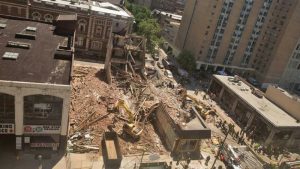
Figure 1. The aftermath of a June 5, 2013, building collapse associated with demolition of a series of adjoining two- and four-story mercantile loft structures onto the immediately adjacent, one-story Salvation Army Thrift Store building in Philadelphia. Courtesy of Lindsay Lazarski, WHYY.
As a result of the incident, both the demolition contractor and operator of the excavator were convicted of six counts of involuntary manslaughter and sentenced to prison. Six months after the incident, OSHA also levied fines against the demolition contractor’s and excavator’s companies. Also, the project developer, the architect who had been hired to monitor the demolition, and the Salvation Army were found to be responsible for the fatalities and injuries by a civil court jury. The ruling resulted in a total settlement of $227 million for the individuals that were killed or injured in the incident.
City of Philadelphia Demolition Ordinance
At the time of the collapse, the City of Philadelphia did not require demolition contractors to document their qualifications. However, as a result of the incident, the City announced two days after the collapse that new demolition rules and standards would be enacted to prevent similar tragedies in the future.
The new City Ordinance documented several new demolition permitting requirements, including:
- Post a notice of the demolition of a structure and distribute notifications to properties adjacent to and near the building to be demolished.
- Site plan.
- Demolition schedule.
- Special Inspections.
- The submission of a Site Safety Demolition Plan or “engineering survey” as required by OSHA that includes:
a) Details of the type of construction and condition of the structure to be demolished.
b) Inspection details of the structural conditions of the adjoining properties.
c) Description of the means and methods of protecting adjacent structures.
d) Description of the method of demolition.
e) Details of potential hazards.
f) Confirmation of the presence of underground utilities.
g) Description of safety and environmental issues.
Continuous demolition Special Inspections were also required by the Ordinance, and must also be overseen by a licensed structural professional engineer for the following conditions:
- Demolition of a building in excess of three stories or 40 feet in height.
- Where the use of mechanized demolition as a part of the Site Safety Demolition Plan, or SSDP, is approved by a licensed structural engineer.
Site Safety Demolition Plan and Special Inspection Project
As a result of the demolition Ordinance, the author became involved in a number of demolition projects. The services provided to clients for demolition projects included the development of demolition bid documents, which are not required by the Ordinance, the engineering review of Site Safety Demolition Plans (SSDP) developed by demolition contractors, and Special Inspections that are performed by a separate inspection and testing division of the author’s firm, Pennoni. One of the most interesting demolition projects that the author has been involved with was the adaptive reuse of the Apex Hosiery Company Building located in Philadelphia, shown in Figure 2.
The renovation of the existing, six-story reinforced concrete manufacturing building involved the demolition of the Penthouse, roof, and 6th and 5th floors, leaving a three-story structure that was to be used as affordable rental housing. Structural engineering services for the project involved both pre-demolition and post-demolition condition assessments of the structure and façade, and Special Inspections during the demolition phase. The pre-demolition survey included the installation of several crack monitors at selected locations within the portions of the building that were to remain for the purpose of monitoring movement of the structure during the demolition phase. The pre-demolition effort also involved a peer review of the SSDP that had already been approved by another engineering firm.
In addition, the author completed a gravity load capacity analysis of the remaining structure to confirm the feasibility of the proposed adaptive reuse of the building. Because there were no existing structural drawings for the building, the load-carrying capacity was determined via small, exploratory demolished openings in the existing concrete slab, used to observe and document the size, spacing, and concrete cover of the internal reinforcing.
Apex Hosiery Company Building History
The original building was designed by Architect Frederick Muhlenberg for use by the Apex Hosiery Company and built in the 1920s; the building was in use until April 1954 when the factory was closed.
By the 1930s, Apex Hosiery, which was much later referred to as the “pantyhose factory”, became the largest nonunion stocking factory in Philadelphia. Company president William Meyers was staunchly anti-union and unlike other northern textile manufacturers at the time he did not move to the traditional non-union South. Instead, he prevented employees from joining the American Federation of Hosiery Workers, or AFHW, union.
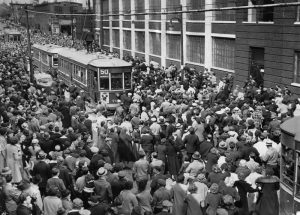
Figure 3. Apex workers backed up by approximately 10,000 unionized hosiery workers from other mills storming the property. Source: George D. McDowell Philadelphia Evening Bulletin Photograph Collection / Temple University Libraries.
However, on May 6, 1937, Apex workers backed up by approximately 10,000 unionized hosiery workers from other mills stormed the property as shown in Figure 3. Meyers and the management team were physically attacked but managed to escape; however, equipment inside the plant was damaged. Nevertheless, after the riot Meyers still refused to give into the union’s demands that the plant be organized, and as a result one of the most famous sit-down strikes in the nation’s history began with nearly 300 strikers remaining in place for approximately seven weeks.
As shipments remained idled during the strike, Apex filed suit and secured an injunction to force the factory to reopen. However, picketing continued, forcing Meyers to allow Apex to become a union shop. Apex management in turn claimed the strike violated antitrust laws by stopping the flow of interstate commerce. Eventually the case made it all the way to the U.S. Supreme Court, which ruled in May of 1940 that the strike did not violate antitrust laws. In the 1950s, Apex began operating at a loss and in April 1954 the factory was closed.
Following a series of ownership changes, the School District of Philadelphia purchased the building in 1967, and the factory floors were converted into classrooms for a middle school. In June 1984, the school was renamed Roberto Clemente Middle School and remained in use until the mid-1990s when a new Clemente school building was constructed elsewhere in the city. The building was subsequently used for storage but became deteriorated and was abandoned in 2007.
Description of Structure
The footprint of the building, which somewhat resembled the shape of the letter F, occupied most of the triangular block bounded by North 5th Street, Rising Sun Avenue, and West Luzerne Street. The 6-story structure was constructed as a reinforced concrete, flat slab supported by round and rectangular columns with column capitals and drop panels, as shown in Figure 4. Laboratory material testing of the existing reinforcing samples and in situ non-destructive evaluation of the existing concrete compressive strength were performed along with field measurements of the critical structural components of a typical framed level. The average in situ concrete compressive strength of 6,000 psi was established via both a Schmidt Impact Hammer and a CAPO-TEST pullout device.
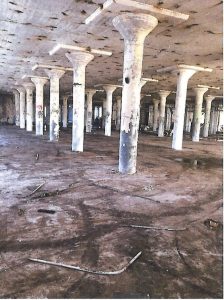
Figure 4. The 6-story structure was constructed as a reinforced concrete, flat slab supported by round and rectangular columns with column capitals and drop panels.
Based on observations at several exploratory openings in the south end of the building, the two-way reinforcing was confirmed to be orthogonal and parallel to the main column grids and did not include any diagonal 4-way reinforcing (Figure 5). The top reinforcing bars were also “trussed,” in other words bent down, towards the bottom of the slab near the edge of the drop panels and thus became the bottom reinforcing, a common method of rebar placement during the era in which the building was constructed.
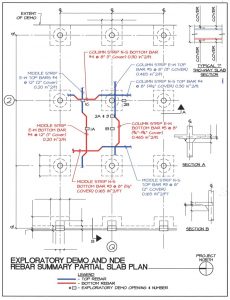
Figure 5. Two-way reinforcing was confirmed to be orthogonal and parallel to the main column grids and did not include any diagonal 4-way reinforcing.
Based on observations at additional exploratory openings in the north end of the building, the reinforcing was confirmed to be the SMI or Smulski Method system, which involved the use of smooth, round concentric rings, or hoops, of small-diameter steel bars as illustrated in Figure 6. The north and south sections of the main rectangular building footprint were separated by an expansion joint; therefore, it was evident that the separate north and south portions of the building had been built using two distinctly different methods of two-way flat slab construction that were available during the era the facility was constructed.
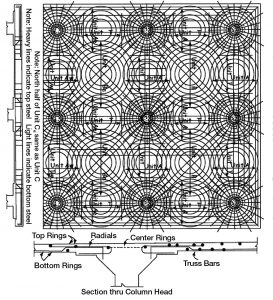
Figure 6. Based on observations, the reinforcing was confirmed to be the SMI, or Smulski Method system, which involved the use of smooth, round concentric rings, or hoops, of small-diameter steel bars. Courtesy of ACI Journal Proceedings, 1918.
A Test of the SMI System of Flat Slab by Edward Smulski
Why this situation occurred during the construction of the building was unclear, particularly in light of a 1922 article from a textile industry publication that indicated a single design/build contractor, Beling-Bush Company, Inc., was awarded the project. However, a review of a historic Sanborn Fire Insurance Map of the property indicates that the north and south sections of the building were constructed at different times. The northern half appears to have been completed first in 1923 by Beling-Bush Company, Inc., while the southern half was completed in 1925 presumably by another contractor. Also, per the same map, the eastern wings of the building associated with the southern half of the facility were completed even later, in 1929.■
Part 2 of this series will provide more details on the SMI system and peer review of the site safety demolition plan.

